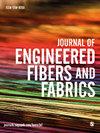Hydrolyzed Reactive Red 195 adsorption on cellulose: Experimental and theoretical investigations
IF 2.2
4区 工程技术
Q1 MATERIALS SCIENCE, TEXTILES
引用次数: 0
Abstract
In this investigation, the mechanism of dye transfer during the mixed washing of natural cellulosic fabrics was elucidated through a comprehensive study of the hydrolysis of Reactive Red 195 (RR 195) and the subsequent adsorption of its hydrolysis products onto cellulose, approached both experimentally and theoretically. Initially, Reversed-phase high-performance liquid chromatography (RP-HPLC) was employed to identify the final products of Reactive Red 195 hydrolysis, collectively referred to as the unfixed dye substance ( UDS). This data provided theoretical insight into the hydrolysis mechanism of the dye. Following this identification, an adsorption kinetic model was established to delineate the interaction of the hydrolysis products with cellulose. Adsorption exhibited its maximal rate at a temperature of 60°C, under conditions of a wash bath ratio of 120:1 and a pH value of 7. Furthering the investigation, a molecular dynamics model was constructed to detail the adsorption process of these hydrolysis products on the hydrophobic surface Iβ(1 0 0) of cellulose within an aqueous environment. This model offered precise insights into the adsorption volume, kinetics, and mechanistic interaction at a molecular scale. Conclusive evidence from both theoretical analyses and experimental results suggested that the hydrolysis products, devoid of reactive groups, were incapable of chemically interacting with the hydroxyl groups inherent to cellulose. Instead, it was discerned that these products underwent a physical adsorption process onto the cellulose surface. Such adsorptive behavior is postulated to be a predominant factor influencing the dye transfer phenomenon in mixed washing conditions.纤维素上的水解活性红 195 吸附:实验和理论研究
在这项研究中,通过对活性红 195(RR 195)的水解及其水解产物在纤维素上的吸附进行全面研究,从实验和理论两方面阐明了天然纤维素织物混合洗涤过程中染料转移的机理。首先,采用反相高效液相色谱法(RP-HPLC)鉴定活性红 195 水解的最终产物,统称为未固着染料物质(UDS)。这些数据为该染料的水解机制提供了理论依据。在鉴定之后,我们建立了一个吸附动力学模型来描述水解产物与纤维素之间的相互作用。在水浴比为 120:1 和 pH 值为 7 的条件下,吸附速率在温度为 60°C 时达到最大。该模型提供了分子尺度上吸附量、动力学和机理相互作用的精确见解。来自理论分析和实验结果的确凿证据表明,没有反应基团的水解产物无法与纤维素固有的羟基发生化学作用。相反,人们发现这些产物在纤维素表面经历了一个物理吸附过程。据推测,这种吸附行为是影响混合洗涤条件下染料转移现象的主要因素。
本文章由计算机程序翻译,如有差异,请以英文原文为准。
求助全文
约1分钟内获得全文
求助全文
来源期刊

Journal of Engineered Fibers and Fabrics
工程技术-材料科学:纺织
CiteScore
5.00
自引率
6.90%
发文量
41
审稿时长
4 months
期刊介绍:
Journal of Engineered Fibers and Fabrics is a peer-reviewed, open access journal which aims to facilitate the rapid and wide dissemination of research in the engineering of textiles, clothing and fiber based structures.
文献相关原料
| 公司名称 | 产品信息 | 采购帮参考价格 |
|---|
 求助内容:
求助内容: 应助结果提醒方式:
应助结果提醒方式:


